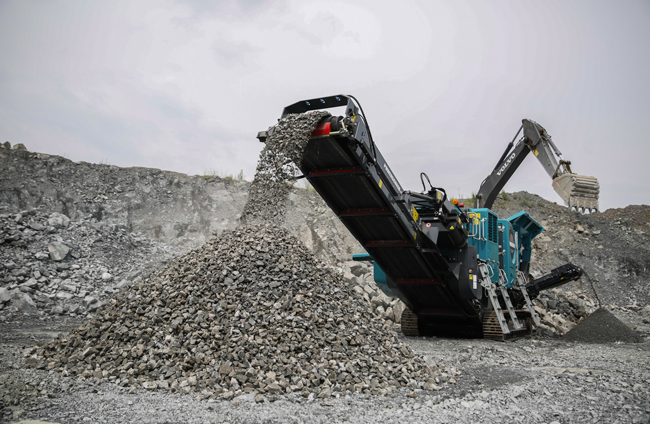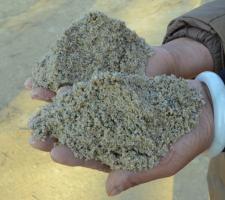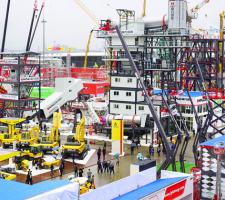
Chinese aggregates demand has been high, linked to rising demand for construction and quarrying equipment, as the ‘One Belt, One Road’ initiative and other transport infrastructure megaprojects, coupled with higher growth in real estate business, have boosted the need for raw building materials. But will the aggregates market buoyancy last? Guy Woodford reports.
China is not just going big on its new transport infrastructure projects – it’s super-sizing them! The hugely ambitious US$4 trillion-plus ‘One Belt, One Road’ Initiative, focusing on connectivity and cooperation between China and its Eurasian neighbours via the land-based Silk Road Economic Belt (SREB) and the ocean-going Maritime Silk Road (MSR), is ongoing.
Other Chinese infrastructure megaprojects include the US$20 billion Hong Kong-Zhuhai-Macau Bridge (HZMB) – a new 55km road, bridge and tunnel link spanning the Pearl River Delta’s Lingdingyang channel via three cable-stayed bridges and one undersea tunnel. HZMB, which is due to open to traffic before the end of the year, will connect three popular destinations in the Pearl River Delta, providing a convenient and cheap option for business travellers and tourists. It will be the world’s longest sea-crossing bridge.
Plans are also being drawn up for a new undersea tunnel in south-east China to improve transport links between the cities of Shenzhen and Guangzhou. The tunnel itself will be around 1.1km long but the project will also include building a 4.45km stretch of road in the DaChan Bay area and a 2.5km stretch of road in Qianhai. The project is expected to cost US$1.67 billion, with the tunnel’s earmarked three-year construction phase due to begin before the end of 2018. Once the tunnel link is ready for use, it will improve traffic connections between the ports of Shekou, Chiwan and Mawan. Much of the traffic using the route is expected to comprise goods vehicles and the link will help reduce congestion on existing roads in the area.
Huge infrastructure works require equally huge volumes of aggregates and construction equipment, and sales of construction equipment in China will exceed 325,000 units this year, according to the Mid-Year Review from Off-Highway Research’s Chinese Service. This tipped 30% year-on-year rise in 2018 will follow on from an 81% increase in demand seen in 2017, compared to the previous year.
The Mid-Year Review from Off-Highway Research, a leading global construction equipment industry market research consultancy, notes that excavators and wheeled loaders are the main equipment sales drivers, and sales growth has been “particularly brisk in the first half of the year”. The review adds: “Wheeled loaders have traditionally been the highest volume machines in China, but last year crawler excavators out-sold them for the first time. That gap is expected to widen further this year, with nearly 140,000 crawler excavator sales against 83,000 wheeled loaders. This year is also seeing strong growth for crawler dozer, mini excavator and mobile crane sales in China.”
Headquartered in Liuzhou, southern China,
David Beatenbough, LiuGong’s vice president of research and development (R&D), has been closely following Chinese construction and quarrying equipment demand. “The recent market growth has two elements shaping demand. The first is fleet replenishments – the first part of the recovery of the last two years was driven by the need to replace older machines that remained in fleets during the depressed industry of the last several years. Now after two years of recovery, the replenishment portion of the recovery should be coming to an end.
“Current increases are being driven more by true increases in demand. There is more work available for machines, confidence is increasing, and fleet expansion is underway.
“The official plan for China’s off-road industry to move to China [Nonroad] Stage IV engine emissions is still to be announced, but it will likely occur at the end of 2019. This will drive a shift in purchasing as customers either advance or delay purchases to optimise their company’s compliance with the new engine regulations.”
Making specific reference to the Chinese quarrying and mining sectors, Beatenbough continues: “Commodity prices have recovered somewhat, so activity is increasing. This is tempered by reforms and controls by the government to improve working conditions in these industries and to manage economic growth according to plan. In addition, many of the large mining customers with state backing are working to reduce their asset base so new purchases are being scrutinised carefully.”
Beatenbough notes China’s increased emphasis on infrastructure development, especially in transport networks, water conservancy, urban underground utilities and environmental improvements. “There are fewer new greenfield projects, but repair and improvements are becoming more important. A key focus area is efficient asset utilisation, and better management of existing projects. All of these factors drive demand in different ways, and demand must be considered on a specific product and size class basis. Some segments will be in decline, while others will increase rapidly.”
Commenting on the Chinese construction and quarrying equipment buyer’s growing preference for excavators over wheeled loaders, Beatenbough says: “Historically, wheeled loaders were used for nearly every job. They were much lower price than excavators, more easily available, and could accomplish nearly any task required, although perhaps not as efficiently as an excavator could in many cases. Now there is much more emphasis on efficiency on jobsites. Utilisation of wheeled loaders in China is becoming more similar to usage patterns in other countries, and the ratio of wheeled loader to excavator is shifting towards the global norm.”
LiuGong’s R&D vice president says certain groups of Chinese quarrying and construction equipment buyers are also very focused on technology. “These customers are very knowledgeable about total cost of ownership and the efficiency of their business. They are very interested in telematics and the information it can deliver. As China works to improve the working conditions in quarries, larger customers with a focus on efficiency will be favoured. These are the customers who want the benefits telematics can deliver. This type of customer is also interested in other technology advances. However, customers in China who are interested in telematics or technology are not willing to pay for it unless they can see direct economic benefits. I think this condition is stronger here than in many other markets.”
Beatenbough believes that Chinese aggregates demand will continue to grow over the next decade albeit at a “controlled and reasonable rate”. He adds: “We expect there will be consolidation in the aggregates industry with the smaller lower tech quarries giving way to more advanced and capable companies. China will continue to invest strongly in infrastructure development especially in the Central and Western regions. This will drive the aggregates business for some years to come.”
According to David Zhao and his team at China Aggregates Net (CAN), who specialise in independent Chinese aggregates market analysis and statistics, demand for manufactured sand production plant has grown markedly since the Chinese government’s introduction over the last year of tougher regulations on the dredging of natural sand from rivers and lakes.
“In late 2017, the dredging of sand from Dongting Lake’s national nature reserves, traditionally one of the major sand sources of cities along Yangtze River, was banned by the Chinese Ministry of Environment Protection. Local government is trying to find new dredge spots outside of the lake’s nature reserves, but available area is limited. Then in June 2018, in a bid to better regulate sand extraction across the whole of China, central government began a nationwide sand dredging check alongside tighter regulation enforcement. These activities will last till the end of 2018.
“While infrastructure construction will not stop, it has pushed the price of construction sand sky high in some places of China. In Zhuzhou in Hunan Province, situated by Dongting Lake, the price of sand was 220 yuan/tonne on 25th June 2018, while in early 2017, the price was around 70 yuan/tonne. In Zhuhai, Guangdong Province, the price was 320 yuan/m³ in August 2018.”
Zhao notes that stricter regulations on natural sand use along with other government-led, environmentally-friendly initiatives have made it tougher for smaller players in China’s aggregates industry. In contrast, the same regulations and initiatives are leading to bigger industry players such as CNBM, CONCH Cement and Sino Hydro investing more heavily in greener quarrying production plant offered by global-selling OEMs.
European global aggregates market OEMs are keen to meet big Chinese demand for new quarrying plant.
The Premiertrak 400X has been designed to run at a low engine RPM, resulting in excellent fuel efficiency and low noise emissions. This lowers operators’ cost per tonne and makes the mobile jaw crusher ideal for urban sites. The machine has an optional post-screen system allowing users to generate a type one product at high volume from one machine. The Premiertrak 400X’s post-screen system has been designed with a quick release feature, to ensure maximum uptime and easy service and maintenance.
Speaking about the Chinese aggregates market before Aggregates China 2018, Willie Yin, Powerscreen sales director in China, said: “The requirement for aggregate products shows no signs of slowing down, in fact our research tells us that there will be even more significant future demand. Global players with a long history, such as Powerscreen, are best placed to serve the needs of Chinese customers who want to increase production, machine uptime and revenues.
“With a strong R&D focus, Powerscreen constantly innovates in its ranges of mobile crushers and screens and machine functionalities. Our technology engineers have been early adopters of the newest technologies, meaning our equipment is optimised to drive customer productivity and experience. This is what sets Powerscreen apart in China.”
Aggregates China 2018 took place 18-20 August at the China Import & Export Fair Pazhou Complex in Guangzhou. As well as welcoming customers onto its stand during the three-day event, Powerscreen held meetings with potential new distributors looking to join the brand’s rapidly expanding professional and customer-driven China dealer network.
Pota will not only be supplying a comprehensive range of Sandvik equipment but will also be providing full aftermarket care, spare parts and dedicated customer service.
A firm specialising in the supply of mobile material handling equipment and dust suppression systems to the Asian market, Pota has a team of 12 sales representatives and six service engineers to support Chinese Sandvik Mobile Crushers and Screens customers.
Commenting on the appointment of Pota, Eugene Lyons, global sales & marketing director for Sandvik Mobile Crushers and Screens, said: “We are delighted to appoint Pota as our distributor in China. This will inevitably open up new opportunities for Sandvik Mobile Crushers and Screens in China and we are excited at the huge potential the market has to offer.”
Many global market quarrying and construction equipment OEMs are focused on their machine and plant line-ups for the 2018 edition of
Given the buoyancy in Chinese aggregates and construction equipment demand, the tighter environmental regulations around the use of natural sand in building works, and the imminent staging of the world’s second biggest construction equipment exhibition, many new construction and quarrying equipment purchases will be made by Chinese customers before the end of 2018. Considering the Chinese government’s ongoing commitment to huge infrastructure spending, growing real estate and manufactured sand demand, the longer-term outlook for the Chinese aggregates industry is just as full of commercial promise.
SDLG & ALIBABA TO BOOST INTELLIGENT CHINESE MANUFACTURING
Majority-owned by Volvo Construction Equipment, SDLG is a construction equipment manufacturer based in Linyi, China, that produces thousands of machines each year. By partnering with Alibaba, a global leader in B2B e-commerce and business intelligence technologies, the company hopes to use such innovations as artificial intelligence, machine-to-machine communication and intelligent devices to modernise its manufacturing. The goal is to boost productivity and reduce waste in its factories, while still delivering high-quality, reliable products to its customers.
Immediately, SDLG plans to begin using Alibaba’s cloud technology to improve procurement and supply chain sourcing, for example, which should help the company become more flexible in its production, as it can better shift among supply partners to meet changing market dynamics. Also, it will use Alibaba’s business intelligence tools to analyse the data of its current operations, which will help the company make more informed business decisions in the future.
“SDLG has been steadily investing in its production processes for years, and this partnership with Alibaba will take these efforts to a new level,” said Wen Degang, general manager of SDLG. “With the deep insight and analytics that Alibaba’s business intelligence expertise can bring, SDLG can further take the lead in such efforts as supply chain sourcing, lean production and digital manufacturing to increase flexibility, operational efficiency and more.”
SDLG’s intelligent or ‘smart’ manufacturing processes already include mechanisms that optimise its machine design process, its production and sales pipelines, for example. Tools provided by Alibaba through the new partnership will give SDLG insight into its own business operations at a level not previously seen.












